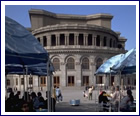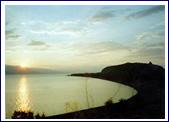Which countries are represented by these flags? For the answers, see at the end of the eNews.

|

|

|
|

|
| 1 | 2 | 3 | 4 | 5 |
|---|

Which countries are represented by these flags? For the answers, see at the end of the eNews.

|

|

|
|

|
| 1 | 2 | 3 | 4 | 5 |
|---|
We’ve all heard horror stories about the deadly Australian funnel-web spiders. A new report in the Lancet shows that deaths from spider bites are extremely rare. Only 26 deaths from spiders have been recorded in Australia in the past century. In comparison, there were 1,183 motor vehicle deaths in 2001 in Australia.
Funnel webs are only found in eastern Australia and there are at least 40 species. They are medium to large spiders, varying from 1-5 cm body length. They like to burrow in moist, cool, sheltered habitats – under rocks, in and under rotting logs, crevices, rot and borer holes in rough-barked trees. In gardens, they prefer rockeries and dense shrubberies, and are rarely found in more open situations like lawns.
Need help? Want a travelling buddy or advice about a place or country – want to share something with us – why not visit our Mutual Aid section of the Website: Mutual Aid
Where is Armenia? Armenia is the smallest of the former Soviet republics, bounded by Georgia to the north, Azerbaijan to the east, Iran to the south, and Turkey to the west. Aremenia counts amongst one of the world's oldest civilizations and once included Mount Ararat, (now in modern day Turkey) the mountain identified in the bible as being where Noah's ark rested after the flood. Under Tigrane the Great (fl. 95-55 B.C.) the Armenian Empire reached its height and became one of the most powerful in Asia, starching from the Caspian to the Mediterranean Seas. Throughout most of its long history, however, Armenia has been invaded by a succession of conquerors- the Greeks, Romans, Persians, Byzantines, Mongols, Arabs, Ottoman Turks, and the Russians.
From the 16th century through to World War I, significant parts of Armenia were controlled by the Ottoman Turks, under whom they experienced discrimination, religious persecution, heavy taxation, and armed attacks. In response to Armenian nationalist stirrings, the Turks massacred thousands of Armenians in 1894 and 1896. After the Turkish defeat in World War I, the independent Republic of Armenia was established on May 28, 1918, but survived only until November 29, 1920, when it was annexed by the Soviet Army. On March 12, 1922, the Soviets joined Georgia, Armenia, and Azerbaijan to form the Transcaucasian Soviet Socialist Republic, which became part of the U.S.S.R. In 1936, after a reorganization, Armenia became a separate constituent republic of the U.S.S.R.
Armenia declared its independence from the collapsing Soviet Union on September 23, 1991. An Armenian Diaspora has existed throughout the nation's history, and Armenian emigration has been particularly heavy since independence from the Soviet Union. An estimated 60% of the total eight million Armenians worldwide live outside the country, with one million each in the U.S. and Russia. Significant Armenian communities are located in Georgia, France, Iran, Lebanon, Syria, Argentina, and Canada.
Armenia – acknowledged as one of the cradles of civilization – is a beautiful country with a sophisticated people and a long and cultured history. As a result, Armenia is an intriguing tourist destination. Numerous monuments and masterpieces of the Ancient era and Middle Ages can be found throughout the country. Tourism in Armenia is rooted in the country's historical landmarks and natural attractions such as the water resorts of Lake Seventh hot springs of Arzni and Jermuk, the forests of Dilijan, Aghveran, Tsaghkadzor, Bjurakan and Gugark, and the mountainous natural caves and cliffs of the Southeast region. The 5165 meter Mount Ararat, geographically located in Turkey, is a national symbol of Armenia and is visible from much of the Southwest region.

 The majestic peaks of Mount Ararat provide a stunning
backdrop to Yerevan. The monastery of Khor-Virab and the ruins of
the ancient city of Dvin (dating back to the second century BC) are
located in the mid-distance Aerial view of Yerevan, capital of
Armenia Statue of Komitas, one of Armenia's most loved
composers, outside the Komitas Conservatory. Apart from writing
many original composition, Komitas travelled the country noting
down folk songs for posterity Yerevan, which is nestled in the
shadow of the snow-capped heights of the majestic mount Ararat,
where the Biblical Noah's Ark first landed escaping the Great
Flood, is the capital city of Armenia. With a population numbering
over 1.2 million, Yerevan is a bustling city. The central plaza,
Republic Square, is designed in the Armenian national style and
houses the Government House, the Cabinet and other governmental
offices as well as the Erebuni and Armenia hotels.
The majestic peaks of Mount Ararat provide a stunning
backdrop to Yerevan. The monastery of Khor-Virab and the ruins of
the ancient city of Dvin (dating back to the second century BC) are
located in the mid-distance Aerial view of Yerevan, capital of
Armenia Statue of Komitas, one of Armenia's most loved
composers, outside the Komitas Conservatory. Apart from writing
many original composition, Komitas travelled the country noting
down folk songs for posterity Yerevan, which is nestled in the
shadow of the snow-capped heights of the majestic mount Ararat,
where the Biblical Noah's Ark first landed escaping the Great
Flood, is the capital city of Armenia. With a population numbering
over 1.2 million, Yerevan is a bustling city. The central plaza,
Republic Square, is designed in the Armenian national style and
houses the Government House, the Cabinet and other governmental
offices as well as the Erebuni and Armenia hotels.
Also situated on Republic Square are the Armenian History Museum and the Art Gallery of Armenia. Here, one finds informative and interesting models and artefacts of ancient Urartu and Armenia. In the Art Gallery one finds a worthy section on Armenian art from the seventh century AD. Amongst the many other museums in the capital city, the two most interesting house museums are those of landscape artist Martiros Saryan (1880-1972) and twentieth century composer Aram Khatchaturyan.
 Yerevan, the ancient capital of Armenia, extends you a
warm and friendly welcome. It is one of the oldest cities in the
world. The earliest recorded settlement there dates back to 782 BC.
King Argishty I founded a fortress city in the north-eastern part
of present-day Yerevan, with the following cuneiform inscription,
“With the majesty of God Khald, Argishty, son of Menua, built
up this inaccessible castle and named it Erebuni…” You can
still see relics from this part of our history at the Erebuni
Museum in Yerevan.
Yerevan, the ancient capital of Armenia, extends you a
warm and friendly welcome. It is one of the oldest cities in the
world. The earliest recorded settlement there dates back to 782 BC.
King Argishty I founded a fortress city in the north-eastern part
of present-day Yerevan, with the following cuneiform inscription,
“With the majesty of God Khald, Argishty, son of Menua, built
up this inaccessible castle and named it Erebuni…” You can
still see relics from this part of our history at the Erebuni
Museum in Yerevan.
 As you explore the many interesting sights in Yerevan, you will
learn about the culture and history of one of the world's
oldest nations.
As you explore the many interesting sights in Yerevan, you will
learn about the culture and history of one of the world's
oldest nations.
If you would like more information about Armenia, contact the author of this article, Mr Mushegh Gevorgyan, who can assist with tours, visas and translation services: tours@orient.am
The 2005 World Airport Awards have voted for the 5th consecutive year Hong Kong International Airport as the world's Best Airport, in the largest customer survey of airport standards. Singapore's Changi Airport takes the Silver Award as runner-up, in what proved to be a close finish to the Survey. The two airports achieved more than 130,000 votes each, with the final margin between 1st and 2nd position being less than 500 votes.
The World's Top 10 Airports are as follows (2005)
Country tatistics: highest population density.
|
Rank |
Country |
Population |
Area (km²) |
Density |
|---|---|---|---|---|
|
6,445,398,968 |
510,072,000 |
13 |
||
|
1 |
449,198 |
25.40 |
17,685 |
|
|
2 |
32,409 |
1.95 |
16,620 |
|
|
3 |
4,425,720 |
692.70 |
6,389 |
|
|
4 |
6,898,686 |
1,092 |
6,317 |
|
|
5 |
27,884 |
6.50 |
4,290 |
|
|
6 |
1,376,289 |
360 |
3,823 |
|
|
7 |
921 |
0.44 |
2,093 |
|
|
8 |
398,534 |
316 |
1,261 |
|
|
9 |
65,365 |
53.30 |
1,226 |
|
|
10 |
349,106 |
300 |
1,164 |
Source: http://en.wikipedia.org/wiki/List_of_countries_by_population_density
Need to convert currency?
Take a look at The Globetrotters Currency Converter – get the exchange rates for 164 currencies The Globetrotters Currency Cheat Sheet – create and print a currency converter table for your next trip.
What is it: there are believed to be at least 15 different types of avian flu that routinely infect birds around the world. The current outbreak is caused by a strain known as H5N1, which is highly contagious among birds and rapidly fatal. Unfortunately, unlike many other strains of avian flu, it can be transmitted to humans, causing severe illness and death.
How do I get it: human cases have been blamed on direct contact with infected chickens and their droppings. People who catch the virus from birds can pass it on to other humans, although the disease is generally milder in those who caught it from an infected person rather than from birds.
What happens if I get it: bird flu can cause a range of symptoms in humans – some patients report fever, cough, sore throat and muscle aches. Others suffer from eye infections, pneumonia, acute respiratory distress and other severe and life-threatening complications.
Diagnose and treatment: flu drugs exist that may be used both to prevent people from catching bird flu and to treat those who have it. Currently there is no vaccine, although scientists are working to develop one.
How can I avoid contracting rabies: the World Health Organization recommends that infected or exposed flocks of chickens and other birds be killed in order to help prevent further spread of the virus and reduce opportunities for human infection. However, the agency warns that safety measures must be taken to prevent exposure to the virus among workers involved in culling.
Need help? Want a travelling buddy or advice about a place or country – want to share something with us – why not visit our Mutual Aid section of the Website: Mutual Aid
Monique is looking for people to share a jeep from beginning September to middle September for a trip down the Rift Valley lakes and into the southwest tribal areas. Cost is 120 USD per day, no matter how many people to the jeep – I will arrive in Addis on Sept 2nd and would prefer to leave the 3rd or 4th of September for a 15-18 days trip (flexible because of market days and so on). Monique can be contacted by e-mail: moniquejansen66@hotmail.com or monique.jansen@chello.be. She says that she is a freelance photographer, so her main goal is: people, villages, markets, less wildlife, birds. If this interests you, why not drop Monique a line.
Here's a little Beetle quiz based on capital cities. See how many you get right! Go on, have a guess!
What is the capital city of the following countries:
For the answers, see at the end of the e-newsletter.
